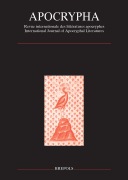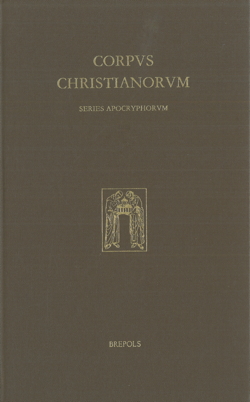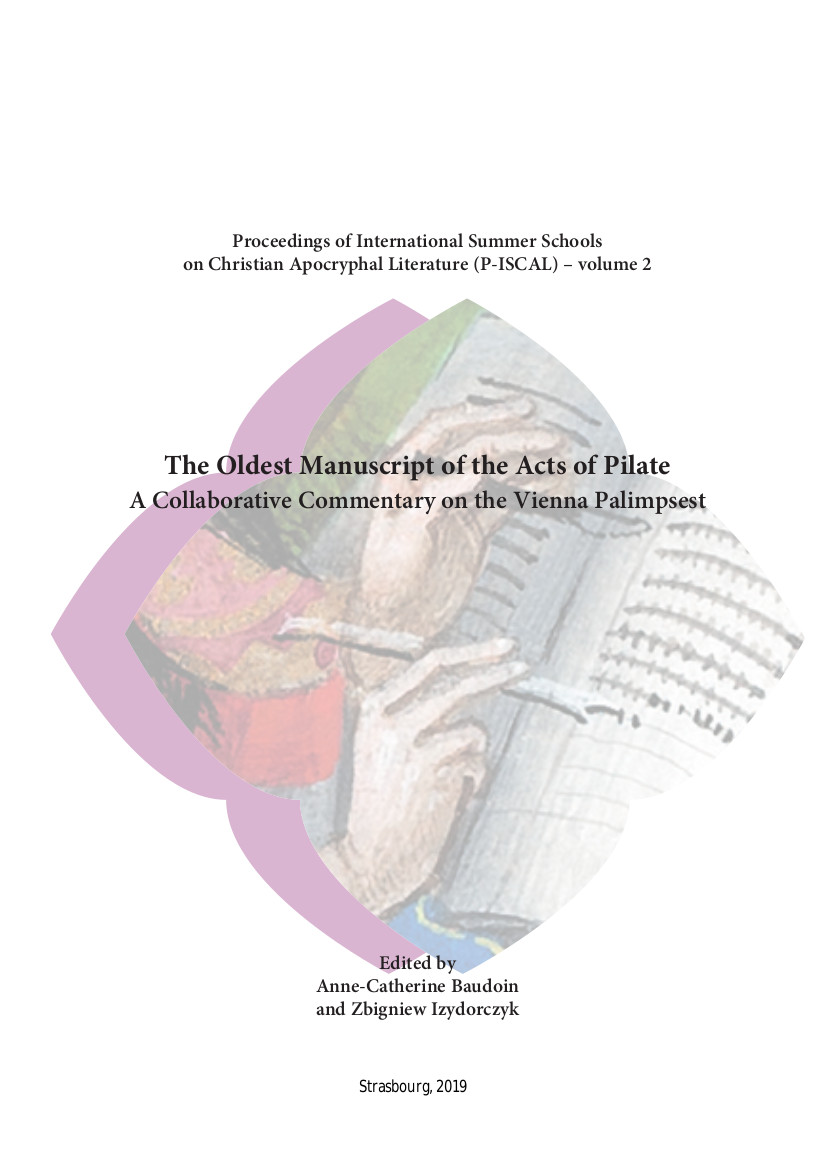Le volume 27 de la revue Apocrypha vient de paraître. Vous trouverez ci-dessous le résumé des articles.
Sommaire
- « Les Actes de Paul et Thècle latins. Édition de la version A et de sa réécriture dans le manuscrit de Dublin, Trinity College, 174 », par Jean-Daniel Kaestli et Gérard Poupon, p. 9-55
- « La Lettera di Pilato a Claudio : uno scritto antigiudaico latino ? », par Alberto D’Anna, p. 111-135
- « The Life of the Virgin Mary According to Middle Byzantine Preachers and Hagiographers : Changing Contexts and Perspectives », par Mary B. Cunningham, p. 137-159
- « Thomas peregrinus. The Apostle as Stranger in the Latin Apocryphal Acts of Thomas », par Els Rose, p. 161-175
- «Towards a Re-Edition of the Ethiopic Dossier of the Apocalypse of Peter : A Few Remarks on the Ethiopic Manuscript Witnesses», par Alessandro Bausi, p. 179-196
- « À propos de trois ouvrages sur Marcion », par Anne-Catherine Baudoin, p. 199-212
« Les Actes de Paul et Thècle latins. Édition de la version A et de sa réécriture dans le manuscrit de Dublin, Trinity College, 174 », par Jean-Daniel Kaestli et Gérard Poupon, p. 9-55
L’édition qui suit se présente à la fois comme un hommage et un complément à l’ouvrage monumental d’Oscar von Gebhardt, Passio s. Theclae virginis. Die lateinischen Übersetzungen der Acta Pauli et Theclae (1902). Elle est le fruit d’une nouvelle recherche sur la tradition latine des Actes de Paul et Thècle (APThe) et apporte une plus grande précision à l’apparat de l’édition du texte grec, préparée par Willy Rordorf et Jean-Daniel Kaestli (à paraître dans la Series apocryphorum du Corpus christianorum). Deux textes sont ici édités, traduits et annotés en regard. La page de gauche contient une nouvelle édition de la version A des APThe latins (latA) sur la base de trois manuscrits : A = Paris, BnF, 5306, XIVe s. ; B = Toulouse, Bibl. municipale, 479, XIVe s. ; Du = Dublin, Trinity College, 174, XIe s. Les deux premiers, copiés sur un même modèle, ont été utilisés par Gebhardt, mais Du était inédit jusqu’ici. Sur la page de droite, on trouve l’édition quasi diplomatique et la traduction du ms. de Dublin, qui se caractérise par l’alternance de passages très proches du texte premier de la version latA et de passages largement réécrits. Le témoignage nouveau de Du permet d’améliorer sous plusieurs aspects le texte édité par Gebhardt comme « Übersetzung A ». Il restitue des passages omis par A B (notamment au chap. 5 et au chap. 43) ; il reflète souvent mieux que A B le texte premier de latA ; il en conserve des traces mêmes dans les parties réécrites ; il permet d’arbitrer entre A et B et d’identifier les leçons secondaires de l’un et de l’autre. Mais le ms. de Dublin est intéressant non seulement comme témoin de la version latA, mais aussi en tant que réécriture originale de cette même version. Cette réécriture présente en effet plusieurs caractéristiques remarquables. Outre l’alternance – dont la logique est parfois difficile à saisir – entre passages inchangés et passages réécrits, il faut relever : (1) la transformation fréquente, mais pas systématique, du discours direct en dis cours indirect, qui contribue à amplifier le texte, et non à l’abréger comme c’est généralement le cas (cf. Monique Goullet, Écriture et réécriture hagiographiques, Turnhout 2005, p. 165) ; (2) la recherche d’un niveau stylistique plus élevé que celui du texte de départ ; (3) le souci de donner au texte un ancrage biblique, qui est une caractéristique des réécritures hagiographiques de l’époque carolingienne (cf. M. Goullet, op. cit., p. 35).
This edition is designed as a tribute and as a complement to the irreplaceable work of Oscar von Gebhardt, Passio s. Theclae virginis. Die lateinischen Übersetzungen der Acta Pauli et Theclae (1902). It is the result of a new research on the Latin tradition of the Acts of Paul and Thecla (APThe) and intends to increase the accuracy of the apparatus of the Greek text edited by Willy Rordorf and Jean-Daniel Kaestli (to be published in the Corpus christianorum, Series apocryphorum). Two texts are edited, translated and annotated on facing pages. The left page contains a new edition of version A of the Latin APThe, based on three manuscripts : A = Paris, BnF, 5306, fourteenth cent. ; B = Toulouse, Bibl. municipale, 479, fourteenth cent ; Du = Dublin, Trinity College, 174, eleventh cent. For his edition, Gebhardt used A and B, which have been copied from the same model, but Du was hitherto unknown. The right page is devoted to a quasi-diplomatic edition and translation of the Dublin manuscript, which is characterised by largely rewritten passages alternating with passages remaining very close to the original text. The new evidence supplied by Du allows improving in several ways the text edited by Gebhardt as « Übersetzung A ». Du preserves some passages omitted by A B (see in particular chapters 5 and 43) ; it often reflects the original text of latA more accurately than A B ; it contains traces of it even in totally rewritten chapters ; it helps arbitrate between A and B and identify the secondary readings of one or the other. But the Dublin MS is of great interest not only as a valuable witness of version latA, but also as a very original rewriting of the same version. This rewriting presents several noteworthy characteristics. Beside the already mentioned alternation of rewritten and unchanged passages – whose logic is sometimes difficult to grasp – three features are standing out ; (1) direct speech is frequently, but non systematically, changed into indirect speech, with the result that the text is amplified, and not abbreviated as it is normally the case (cf. Monique Goullet, Écriture et réécriture hagiographiques, Turnhout 2005, p. 165) ; (2) the rewriter aims at enhancing the style of the source text ; (3) he strives to anchor the text in the Biblical world, as it happens with hagiographical rewritings of the Carolingian period (cf. M. Goullet, op. cit., p. 35).
« La Lettera di Pilato a Claudio : uno scritto antigiudaico latino ? », par Alberto D’Anna,
p. 111-135
Starting from some Max Bonnet’s remarks, the article discusses the relationship between the Latin text and the Greek texts of the Letter of Pilate to Claudius, transmitted by the three recensions of the Acts of Peter and Paul : it seems possible to confirm and also to sustain more the linguistic and textual priority of the Latin form. The article considers then the issue of the early state of the Letter, if independent or since the beginning part of the Acts : on the basis of arguments relating to content and narrative, the independent origin is held the most reasonable.
A partire da alcune osservazioni di Max Bonnet, l’articolo affronta il tema della relazione tra il testo latino e i testi greci della Lettera di Pilato a Claudio, trasmessi dalle tre recensioni degli Atti di Pietro e Paolo : appare possibile confermare e anche maggiormente sostenere la priorità, linguistica e testuale, della forma latina. L’articolo, poi, considera la questione dello statuto originario della Lettera, se indipendente o sin dall’inizio parte degli Atti : in base ad argomenti di ordine contenutistico e narrativo, l’origine indipendente è ritenuta maggiormente plausibile.
« The Life of the Virgin Mary According to Middle Byzantine Preachers and Hagiographers : Changing Contexts and Perspectives », par Mary B. Cunningham, p. 137-159
This article examines the Byzantine homiletic and hagiographical treatment of the Virgin Mary, “Theotokos” or “Birth-giver of God”, seeking to determine why diverse narratives concerning this holy figure began to appear from about the early ninth century onward (assuming, in agreement with Phil Booth’s recent article, that the Greek prototype for the Georgian Life of the Virgin that is attributed to Maximos the Confessor should more probably be dated to the tenth century). The divergences, which may reflect various early apocryphal traditions, follow somewhat generic lines : whereas homilies, which were delivered in the context of liturgical vigils or eucharistic celebrations and incorporated well-known narratives such as the Protevangelium of James and versions of the Transitus Mariae, three Marian hagiographical works reflect a variant version of the Virgin’s legendary biography. The present study seeks not only to identify some of the more important variations in post-ninth-century narrative traditions surrounding the Virgin Mary, but also to examine the didactic purposes of preachers and hagiographers. It is likely both that ongoing Christological discussions played a part in inspiring Byzantine reflection on Mary, as human mother of Christ and intercessor, and that monastic revival caused greater focus on the Virgin’s ascetic and apostolic qualities in this period.
Cet article examine le traitement de la Vierge, « Theotokos » ou « Mère de Dieu », dans la tradition homilétique et hagiographique by- zantine, et tente d’expliquer les raisons des nombreuses différences dans les récits de sa vie à partir du IXe siècle. Nous acceptons ici la proposition récente de Phil Booth de dater le prototype grec (attribué à Maxime le Confesseur) de la Vie de la Vierge géorgienne d’après le Xe siècle et non pas, comme Michel van Esbroeck et Stephen Shoemaker l’ont proposé, au début du VIIe siècle. Les différences entre les traditions homilétiques et hagiographiques que nous avons constatées paraissent à la fois suivre des traditions apocryphes différentes et se conformer à leurs propres formes littéraires. En effet, alors que les homélies, composées pour des offices ou liturgies eucharistiques reprennent des récits bien connus tels que le Protévangile de Jacques et des versions du Transitus Mariae, trois textes hagiographiques reflètent quant à eux une autre variante de la vie légendaire de la Vierge. Dans cette étude, nous essayons non seulement d’identifier les différences dans la tradition narrative concernant la Vierge Marie après le IXe siècle, mais nous examinons aussi l’objectif didactique des prêtres et des hagiographes. Il est possible que les discussions christologiques aient continué d’influencer la réflexion byzantine sur la Mère de Dieu à cette époque, mais aussi qu’une renaissance monastique ait conduit à insister davantage sur ses qualités ascétiques et apostoliques.
« Thomas peregrinus. The Apostle as Stranger in the Latin Apocryphal Acts of Thomas », par Els Rose, p. 161-175
In the apocryphal Acts of Thomas, the apostle Thomas is presented as a stranger (?????, peregrinus). The present article explores how in the late Roman rewritings of the ancient Acts, the position of the apostle as an outsider is highlighted as an essential part of his role in the process of conversion and Christianisation. Whereas previous publications in Apocrypha have signalled Thomas’ identity as a “stranger” (?????) and his appeal to his converts to become “strangers” with him in the ancient Acts of Thomas (Drijvers 1990, Myers 2006), the Latin rewritings of this apocryphon are at the centre of the present contribution. These texts give a detailed account of the way the apostle, as an outsider, transforms the cities of his mission area from within into Christian communities. The Latin rewritings of the Acts of Thomas thus form a representation of a paradoxical approach to the binary opposition of insider and outsider, presenting Thomas emphatically as a “stranger” as opposed to civis. At the same time, the Passio Thomae (BHL 8036) in particular emphasises in an elaborate digression the way the apostle grants his converts an inalienable share in a new civic identity, which concerns both life in the Christian community on earth and, eschatologically, life in the heavenly city.
Les Actes apocryphes latins de Thomas présentent l’apôtre comme un « étranger » (?????, peregrinus) à maintes reprises. Le présent article cherche à savoir comment, dans le monde romain antique tardif et médiéval, cette qualité d’étranger représente un aspect essentiel du rôle de l’apôtre dans le processus de conversion et de christianisation. Tandis que l’identité de Thomas comme « étranger » dans les Actes de Thomas anciens et son appel aux convertis à devenir eux aussi des « étrangers » ont été étudiés dans divers articles d’Apocrypha (Drijvers 1990, Myers 2006), les réécritures latines de cet apocryphe montrent en détail comment l’apôtre comme « outsider » transforme les civitates Indorum en communautés chrétiennes. Ainsi, les Actes de Thomas latins représentent une approche paradoxale de l’opposition entre citoyens et étrangers, en présentant Thomas explicitement comme « étranger » opposé à civis. La Passion de Thomas (BHL 8036), en particulier, illustre dans une interpolation élaborée de quelle manière l’apôtre accorde à ses convertis une nouvelle identité civique inaliénable à la fois dans la société chrétienne terrestre et, eschatologiquement, dans la cité céleste.
«Towards a Re-Edition of the Ethiopic Dossier of the Apocalypse of Peter : A Few Remarks on the Ethiopic Manuscript Witnesses», par Alessandro Bausi, p. 179-196
The second-century Apocalypse of Peter (ApPt) is transmitted in its entirety only in an Arabic-based Ethiopic translation within a pseudoclementine dossier composed of The second coming of Christ and the resurrection of the dead and the A speech on the glorious and arcane mystery of the judgment of sinners and a dispute concerning this speech. The codicological analysis of the two manuscripts – BnF, éthiopien, d’Abbadie 51 (P), and Lake ??n?, ??n?see 35 = Kebr?n 35 (T) – transmitting the dossier shows that the Ethiopic ApPt dossier goes back to a larger collection. Moreover, there are clues that the blank of a few lines that interrupts, without any apparent omission or material loss, the text of ms P on fol. 141vb, is most probably due to team work. The colophon of ms T confirms the marked heterodox character of the Ethiopic dossier. After the important contributions by Dennis D. Buchholz and Paolo Marrassini, a new edition of the entire dossier is planned for the Corpus Christianorum Series Apocryphorum.
L’Apocalypse de Pierre (ApPt), datée du deuxième siècle, est transmise intégralement par une traduction éthiopienne qui repose sur un modèle arabe, dans un dossier pseudo-clémentin qui est composé de La seconde venue du Christ et la résurrection des morts et d’Un discours sur le glorieux et arcane mystère du jugement des pécheurs et une dispute concernant ce discours. L’analyse codicologique des deux manuscrits – BnF, éthiopien, d’Abbadie 51 (P), et Lac ??n?, ??n?see 35 = Kebr?n 35 (T) – qui transmettent ce dossier, montre que le dossier éthiopien de l’ApPt remonte à une collection plus étendue. En outre, des indices révèlent que le blanc de quelques lignes qui interrompt, sans aucune omission apparente, le texte du ms P au fol. 141vb, est probablement la conséquence d’un travail d’équipe. Le colophon du ms T confirme le caractère hétérodoxe marqué du dossier éthiopien. Après les contributions importantes de Dennis D. Buchholz et Paolo Marrassini, une nouvelle édition du dossier entier est envisagée pour le Corpus Christianorum Series Apocryphorum.
« À propos de trois ouvrages sur Marcion », par Anne-Catherine Baudoin, p. 199-212
Étude critique de:
- Lieu, Judith M., Marcion and the Making of a Heretic. God and Scripture in the Second Century, Cambridge, Cambridge University Press, 2015, 502 p. ISBN 978-971-107-02904-0
- Roth, Dieter T., The Text of Marcion’s Gospel (New Testament Tools, Studies and Documents 49), Leyde-Boston, Brill, 2015, 491 p. ISBN 978-990-04-24520-4
- BeDuhn, Jason, The First New Testament. Marcion’s Scriptural Canon, Salem (OR), Polebridge Press, 2013, xiv + 387 p. ISBN 978-971- 59815-131-132



